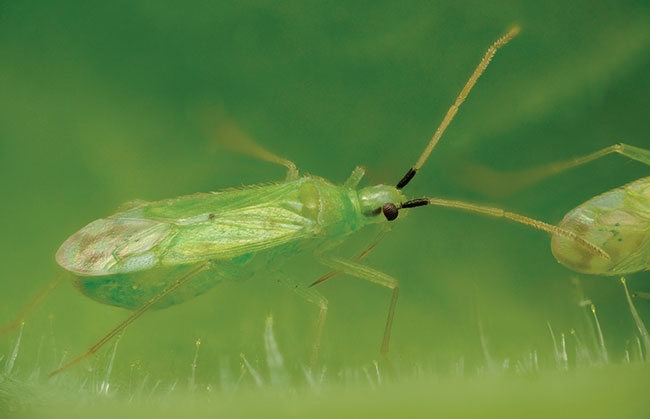
Features
Biocontrols
Inputs
Help wanted! The case for new biocontrol agents
With the global movement of plant material, a changing climate and resistance among pest populations, is it time we brought in new biocontrol agents?
January 2, 2019 By Dr. Michael Brownbridge and Dr. Rose Buitenhuis
 Macrolophus pygmaeus. This generalist predator feeds on a wide range of pest species and now underpins biocontrol programs in many European vegetable greenhouses. Photo credit: Dr. Gerben Messelink
Macrolophus pygmaeus. This generalist predator feeds on a wide range of pest species and now underpins biocontrol programs in many European vegetable greenhouses. Photo credit: Dr. Gerben MesselinkGreenhouse production in Canada is growing and evolving. Tomatoes, cucumbers and peppers have traditionally been the primary crops grown in Canadian vegetable greenhouses, while the floriculture sector has been producing a wide range of potted plants, bedding plants and cut flowers.
In recent years, the diversity of food crops has expanded to include lettuce, green beans, eggplant, various herbs and microgreens, strawberries and raspberries, along with an increased diversity within each vegetable category. Over the last two years we have also seen tremendous growth in the production of ‘medicinal’ crops. Market demand has stimulated some of these developments, and greater unpredictability in weather events as a result of climate change has also prompted moves toward production in protected structures.
The greenhouse environment, while ideal for crops, also favours many arthropod pests and plant diseases, which in turn have to be managed. Aided by international movement of plant material (finished and propagative) and a changing climate, the risks of pest incursions – both new and known – have never been greater. Resistance within these pest populations is widespread, and we are faced with declining access to new chemistries. Market forces are also influencing the agricultural landscape with rising demands (driven by consumers) around agri-environmental sustainability and food provenance. To meet these challenges, the greenhouse sector has embraced the use of biological control within integrated crop management programs and biocontrol is now successfully practiced in Canada over a diverse variety of ornamental and vegetable crops.
This evolution in crop management is not unique to Canada though, and demands for biocontrol services are growing worldwide. This has placed an enormous stress on biocontrol companies just to keep up with orders for their existing products, let alone develop products for new pests on new crops. The challenge to researchers and the biocontrol industry is to devise ways in which biocontrol strategies can evolve to meet these growing demands.
The need for new biological control agents
Biocontrol strategies largely rely on regular releases of natural enemies, including specialist predators or parasitoids, and applications of microbial biopesticides or nematodes. Despite the development of sophisticated biocontrol programs, pests such as whiteflies, spider mites, thrips and aphids remain an ongoing challenge. Biologicals do not work equally well in all crops or jurisdictions. Moreover, some pests currently have no biological solutions and changes in the prevalence of closely related species, e.g., onion thrips vs. western flower thrips, undermine the efficacy of established biocontrol programs. As a result, growers are periodically forced to use pesticides and few of them are truly compatible with natural enemies. How can we eliminate the need for pesticide intervention, preserve the integrity of biocontrol systems, and conform to market demands for ‘pesticide-free’ produce? Part of the solution lies in the development of new natural enemies that will strengthen bioprograms and expand the range of pests that can be successfully managed in this manner.
How would new biocontrol agents help?
Over the past 20 years several new biocontrol agents have come to market, although most have been introduced in Europe. There have been significant successes. For example, until relatively recently, weekly pesticide sprays were a common (and failing) practice in tomato and eggplant greenhouses in southern Europe against Bemisia whitefly and Tuta absoluta (a biosecurity threat to Canada). This all changed when Macrolophus pygmaeus was introduced. Macrolophus is an aggressive, generalist predator with a wide prey range and its introduction provided the additional control needed to allow biocontrol programs to succeed. Today, pesticide sprays have virtually been eliminated in European vegetable greenhouses as a result of the predator’s introduction. This is one example of how a top predator can positively influence a biocontrol program. Several studies have shown that biocontrol efficacy tends to be higher when generalist biocontrol agents are included.
Faced with a number of hard-to-control pests like aphids, thrips and spider mites, alongside those which currently lack effective biocontrol options, such as mealybugs, scales, echinothrips and pepper weevils, why don’t we simply import proven generalists into North America? This is not an option since regulations prevent the importation of non-native generalists like Macrolophus pygmaeus into Canada and the United States. Predatory insects, mites and parasitoids occur naturally across North America; maybe the time has come to start looking for ones which have the correct characteristics to become ‘products’, filling the gaps and strengthening augmentative biocontrol programs in floral and vegetable crops.
Homegrown solutions
To develop a commercially viable product (viable from a producer’s and end user’s perspective), we have to take a strategic approach to the discovery, evaluation and development of new biocontrol agents. This framework needs to incorporate critical go/no-go points so that only those with the requisite traits for commercial production and use are advanced. The first phase is informed by need and driven by performance, and should result in candidates which have all the basic requirements to become biocontrol products. Further testing to validate performance in commercial greenhouses, determine capacity to scale production, and devise appropriate methods to harvest and ship natural enemies will doubtlessly weed out the weak candidates while bringing to the forefront the strongest ones. Resources should then be focused on those with the greatest likelihood of success.
No single organization can carry out all of the research required. Rather, a collaborative approach among researchers and industry, from start to finish, allows resources to be used most efficiently. The integration of commercial partners also brings considerable know-how, focus and rigour to the selection and advancement of biocontrol agents, and is clearly essential for their commercialization.
Biologicals work best when applied into a production system that supports their success. There are opportunities to refine cultural practices to improve the basic health and resilience of plants, making them less susceptible to pests and diseases. This includes greater use of genetic resources in the form of host plant resistance against both diseases and pests, which can be a foundational component of IPM.
Biological control alone is no magic bullet, but it offers many advantages when used as part of an IPM strategy. It supports sustainable growth, enhanced productivity and production efficiency, while protecting the environment and providing safer working conditions for greenhouse employees. Such practices promote public trust in the quality and safety of Canadian greenhouse produce and plants, enhancing the industry’s competitiveness in domestic and export markets. It delivers to the holy grail of sustainability and the triple bottom line in terms of providing economic, environmental and social benefits.
Help wanted? Yes, it’s time to consider the résumés of some candidate organisms. New biocontrol agents will be looking for work soon in a greenhouse near you!
Michael Brownbridge, PhD, is research director of horticultural production systems, and Rose Buitenhuis, PhD, is the research scientist in biological control at Vineland Research and Innovation Centre.
Print this page

